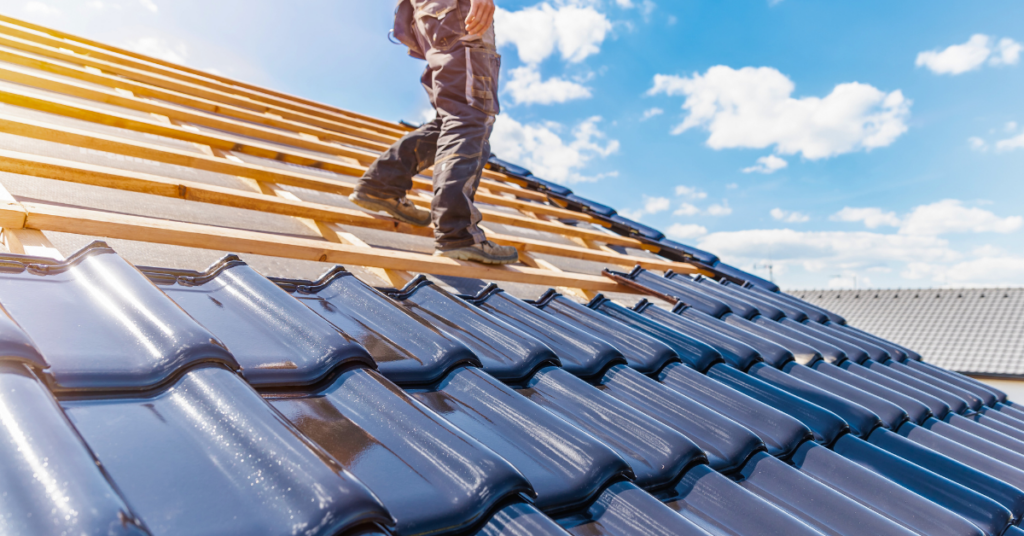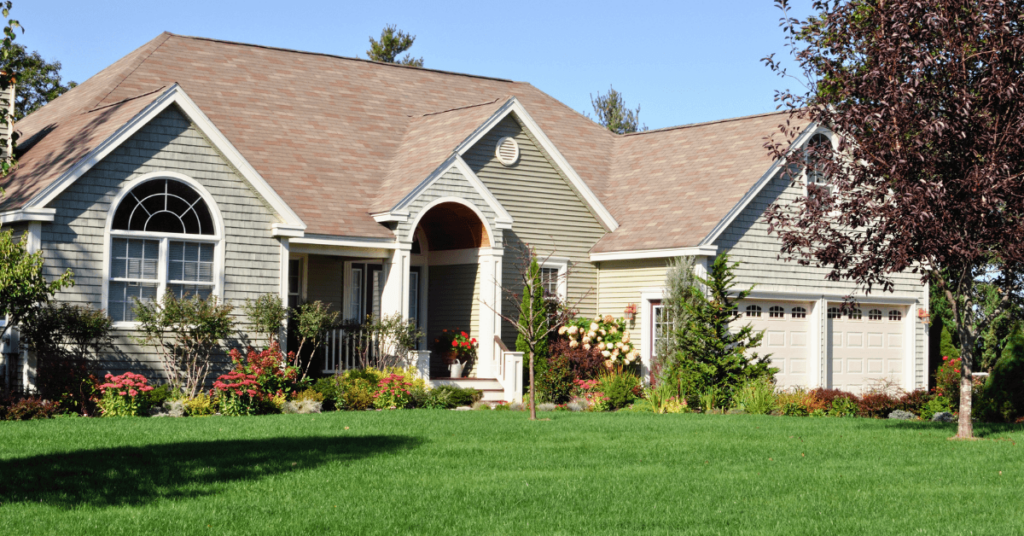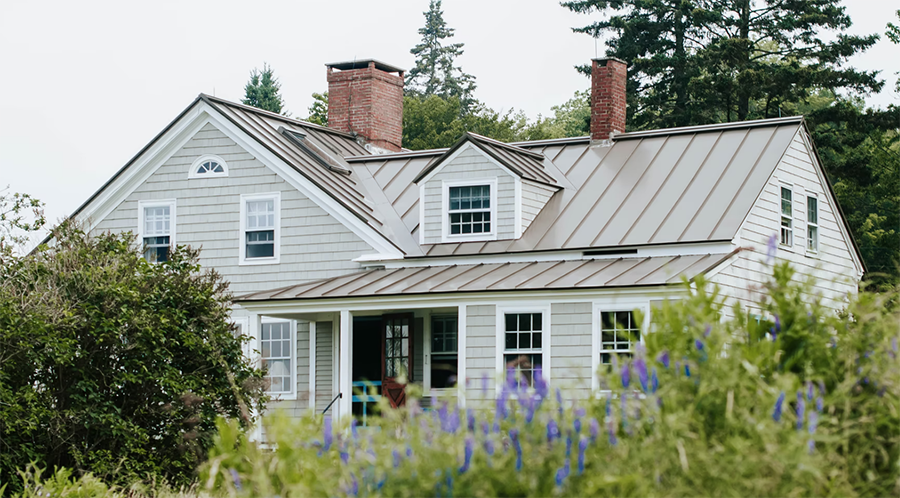January 26, 2024 in Roof Replacement
New Beginning Overhead: Navigating Roof Replacement
Imagine you’ve just settled down to go to sleep, and as you pull up the covers, you look up and see a slight bulge in your ceiling. This could be a signal that it’s time for a new roof. As time passes, wear and tear can take a toll and make a replacement necessary. Be on the lookout for leaks, missing shingles, or drooping areas. If it’s showing signs of aging it might be time to look into a roof replacement.
Step 1: Identify a Roofing Contractor
Selecting the right professional for the job is paramount. Research contractors, read reviews, and ask for recommendations. Finding someone reliable ensures you’ll have a smooth process and a final result that’s made to last. Rest assured, you can trust us. We’re committed to providing quality workmanship that’s made to last.
Before starting this project, make sure you have all of the required permits. This not only keeps you in compliance with local regulations but also guarantees that the work meets safety and quality standards.
It’s helpful to understand all of the costs associated with a roof replacement. The total cost may vary depending on size and materials used. We offer many different material choices including:
- Copper
- Slate
- Synthetic
- Metal
- Cedar Shade
You should also get detailed quotes from several contractors and take into account materials, labor, and any potential unforeseen expenses. Knowing the average cost of a roof replacement and having a clear budget will help you make informed decisions.
Step 2: Roof Inspection and Assessment
A comprehensive inspection is the foundation of a successful roof replacement. Roofing contractors will assess the condition of your existing roof, identifying areas requiring attention to fully understand the scope of the project.
Whether the problems are localized or widespread wear and tear, having a clear understanding of the scope ensures nothing is overlooked. Identifying the extent of the damage will help you plan for any necessary repairs or structural improvements so they’re completed properly and will function effectively for years to come.
Maintaining open communication with your roofing contractors is key. Discuss findings from the inspection, ask questions, and seek advice. A collaborative approach helps keep you and the contractor on the same page throughout the entire process. If you’re looking for a roofing contractor who will focus on collaborating with you, reach out to us.
Step 3: Choosing Materials for Roof Replacement
From traditional asphalt shingles to modern metal or slate options, each material has unique characteristics that vary in durability, appearance, and cost. When you’re about to replace your roof, consider factors such as climate, architectural style, and personal preferences when making your selection. If you understand the pros and cons of each material, it will be easier to make an informed decision based on your preferences and budget. Since not all roofs are the same, you may want to include something that fits your home’s style. This can include adding extra features or decorative elements like decorative trim, gutters, or a skylight to improve the look of your new roof and give your home a renewed appearance. Making the right choices ensures your roof’s longevity while enhancing your home’s appearance, and elevating its curbside appeal.
Step 4: What is the Average Cost of a Roof Replacement?
When planning for a roof replacement, it’s important to consider the average cost of roof replacement and the various factors that contribute to it. One of the primary considerations is the type of roofing material being used. Different materials, such as asphalt shingles or metal come with varying costs and lifespans. It’s important to weigh the upfront cost against the long-term durability and maintenance requirements of each material you’re considering.
Another crucial factor to consider is the size and complexity of the roof. Larger roofs or those with intricate designs may require more materials and labor, thus increasing the overall cost of the replacement. Additionally, the condition of the existing roof and any necessary repairs or preparatory work can also impact the total cost.
Furthermore, it’s essential to factor in the cost of labor and installation when planning for a roof replacement. Hiring experienced and reputable roofing professionals may come at a higher cost, but it can ensure the quality and longevity of the new roof. It’s important to obtain multiple quotes from different contractors to compare costs and services.
Remember when considering a roof replacement, it’s crucial to balance quality with cost and to consider the long-term benefits of investing in high-quality materials. Taking into account the average cost of roof replacement and the various factors that contribute to it can help in making informed decisions and ensuring a successful and cost-effective replacement. You should also consider the potential energy savings that come with higher-quality materials, as they can result in lower utility bills over time. For more information, get in touch with us.
Step 5: Roofing Contractor Scheduling and Logistics
Establish a realistic timeline for this project. Consider factors like weather conditions and the availability of materials to make the process as smooth and timely as possible. Coordinate with your crew and keep open communication lines to minimize disruptions.
You should know that you may need to make temporary living arrangements to avoid major inconveniences. This could mean staying at a friend’s house, entering your own home through the back door, or simply parking your car on the street instead of in your driveway.
Our Approach: Safety First
At PJ’s Roofing Safety is always a top priority during the removal and replacement process. We use appropriate safety gear and adhere to industry best practices to minimize potential safety risks for a smooth and incident-free roof replacement.
So what are those best practices? Experienced crews follow a systematic demolition and removal process so that old materials are safely removed without causing damage to the underlying structure. Reputable contractors adhere to proper waste disposal practices, recycling whenever possible. This reduces any negative environmental impact, aligning with sustainable construction practices.
Step 6: Installing Your Roof Replacement
A strong roof needs solid underlayment and decking. Make sure your contractor focuses on these layers for extra protection and strength. Next comes the installation of the selected roofing materials. Quality control checks are essential, and contractors should conduct thorough inspections to identify and correct any issues promptly, making certain that the final product meets the highest standards.
If all of that sounds like a lot, here’s a sample timeline you can use to know what you should expect to happen when. Keep in mind this is an estimated timeline, and depending on factors such as schedules and the materials you select for your new roof, your timeline may differ.
- Preparation (1-2 weeks prior to installation)
- Select and order roofing materials.
- Obtain necessary permits if required.
- Arrange for the delivery of materials to the site.
- Day 1: Removal of Old Roofing
- The old roofing materials are removed, and the roof deck is inspected for any damage.
- Day 2: Decking and Underlayment
- Any damaged decking is replaced or repaired.
- Installation of high-quality underlayment and decking to provide a solid foundation for the new roof.
- Day 3–4: Installation of Roofing Materials
- The selected roofing materials are installed according to the manufacturer’s specifications.
- Day 5: Quality Control Checks
- Contractors conduct thorough inspections to ensure that the installation meets the highest standards.
- Any issues are identified and promptly corrected.
- Final Inspection and Cleanup
- A final inspection is conducted to ensure the roof replacement meets all quality standards.
- Cleanup of the work area and removal of any debris.
This timeline is a general guideline and may vary based on the size of the project, weather conditions, and other factors. It’s essential to work closely with your contractor to establish a more specific timeline for your roof replacement project.
Step 7: Roof Inspection and Final Touches
Once the installation is complete, an inspection is performed to make sure every aspect meets the agreed-upon standards. In the event of issues arising, a reputable contractor addresses them promptly. Your satisfaction is paramount, and any concerns you have should be resolved at this time. At PJ’s Roofing, we’ve helped many happy customers. Check out what they have to say.
Clean-up and Maintenance Tips
The job isn’t complete until everything’s thoroughly cleaned up. Removing debris and waste not only keeps your property tidy but also prevents damage. A clean site reflects the professionalism of the contractor. We’re proud to be an expert roofing contractor in Frederick committed to providing the highest quality and best practices for continued maintenance.
Being proactive and following any maintenance guidelines your contractor provides including regular inspections and minor repairs will help to keep your roof in optimal condition.
Warranty Information
If you get a warranty, It’s important for you to understand all of its terms. Some common benefits you can expect include protection against defects in materials or workmanship, coverage for repairs or replacements of faulty roofing materials, and coverage for labor costs associated with fixing any issues that may arise. Additionally, warranties may also include coverage for damage caused by severe weather, such as wind or hail damage. It’s important to carefully review the terms of the warranty to fully understand what is covered in your particular policy. Reputable roofing contractors like the experts at PJ’s Roofing will provide clear information, explaining your coverage and its duration. This allows you to have confidence in the longevity and reliability of your new roof.
Enjoying the Benefits
Replacing your roof is a significant undertaking that, when done with diligence and expertise, provides longevity and resilience. This requires careful planning, collaboration, and skilled craftsmanship. From the initial assessment to the final touches, each step contributes to the success of the project. Once it’s in place, it’s time to enjoy the numerous benefits including enhanced protection, improved energy efficiency, and a visually appealing exterior to your home.
Are you ready to enjoy the benefits of a new roof? Contact us today for more information and start your roofing project with confidence.













